History of Rivne
Rivne in the 13th-17th century
The first known written mention of Rivne as one of the settlements of the Kingdom of Galicia-Volhynia dates back to 1283. This is a Latin entry in the Polish chronicle “Rocznik kapituly krakowskiej”.
From the second half of the 14th century, Rivne was under the rule of the Grand Duchy of Lithuania. In a charter of 1434, it was mentioned among other Volhynian settlements as the property of the Lutsk gentry Dichko. The document dated December 22, 1461 speaks of its sale: Ivashko Dichko sold Rivne to Prince Semyon Vasilyevich Nesvitsky, a representative of the Gediminids dynasty of monarchs.
After the death of the prince in 1479, Rivne became the property of his wife Maria, who began to call herself the princess of Rivne. By her order, a castle was built from oak logs. The princess began to invite artisans and craftsmen here, who gradually settled in the streets adjacent to the castle. The original town resembled a triangle in plan, its streets diverged in three directions. It was possible to enter Rivne from three directions. Hence the symbolism of the first Rivne coat of arms - gates open for entry on three sides, which is repeated on today’s city coat of arms.
In 1492, the Polish king and Grand Duke of Lithuania Kazimir Jagiello granted Magdeburg rights to Rivne. After the Union of Lublin of 1569, Rivne became part of Poland as a town in the Lutsk district. The census of 1629 recorded that there were 505 houses and more than 3 thousand residents in Rivne. At that time, the population of Kyiv was about 18 thousand people.
More Historical Facts…
In the summer of 1651, this region became the center of the liberation struggle of Ukrainians under the leadership of Bohdan Khmelnytsky (the Khmelnytsky Uprising, also known as the Cossack-Polish War of 1648-1654). During the fighting, Rivne changed hands more than once.
In 1667, as a result of the Truce of Andrusovo between the Tsardom of Russia and the Polish-Lithuanian Commonwealth, Rivne, as part of the Volhynia lands, remained part of the Commonwealth. All these events had a great influence on the decrease in the local population. The process of the decline of the town began. It was further intensified by the great fire of 1691.
Rivne in the 18th-19th centuries
In 1706, during the Great Northern War (1700-1721) between the Tsardom of Russia and the Swedish Empire, Rivne was occupied by the troops of the King of Sweden Charles XII, who also visited the town. From 1723, for almost a century and a half, Rivne became the property of the Polish princely family of Lubomirski, the richest magnate family in Volhynia, and sometimes in all of Poland.
During this period, significant changes began in the life of the town. The Rivne castle was rebuilt, which was then in ruins and desolation. The Lubomirski patronized the Jews, who at that time were experiencing oppression in neighboring European countries, which led to their mass resettlement in Rivne. Over time, they settled in one of the districts of the town, which significantly and for many years affected the life of the town.
In 1765, there were 683 buildings in Rivne, including 313 in the suburbs, which were developed on a national and social basis. There were German and Jewish streets, quarters of town officials, clergy, artisans, etc. In 1792, the national hero of Poland, General Tadeusz Kosciuszko, visited Rivne to meet Ludwika Lubomirska, the then mistress of the Rivne Palace.
In 1793, the second partition of Poland took place, and Russian troops entered Rivne. According to the new administrative division of the Volhynian lands, Rivne acquired the status of a county center as part of the newly formed Volhynian Governorate of the Russian Empire. This helped revitalize the development of Rivne. Officials of county institutions came and settled here, basic household amenities were created (horse transport, post office, etc.).
In 1837, the construction of the gymnasium began. In 1844-1845, Nikolai Kostomarov, an outstanding Russian historian, writer and public figure, worked as a senior lecturer in history in the Rivne gymnasium. In 1858, the population of Rivne was about 5 thousand people. In 1873, the Kyiv-Brest railway passed through Rivne.
Rivne in the first half of the 20th century
In 1906, the first museum was opened in Rivne. In 1912, the first power station was put into operation. During the First World War, Rivne was a front-line town for several years. In 1916, before the offense of the Russian troops, Emperor Nicholas II and General Alexei Brusilov visited it.
In the period from 1917 to 1920, during the Civil War on the territory of the former Russian Empire, Rivne was alternately controlled by the Austro-German, Polish and Bolshevik troops. On September 19, 1920, Rivne was again occupied by Polish troops. Until September 1939, it was part of Poland as the county center of the Volhynian Voivodeship. In 1921, the population of the city was about 30 thousand people, in 1939 - 43 thousand.
In September 1939, in accordance with the Molotov-Ribbentrop Pact, as a result of the Polish campaign of the Red Army, Western Ukrainian lands were annexed to the Ukrainian Soviet Socialist Republic. Rivne acquired the status of the regional center of the newly formed Rivne Oblast.
On June 28, 1941, during the Second World War, Rivne was captured by German troops. The city was turned into a kind of “capital” of the occupied Ukrainian lands. From August 20, 1941 to February 2, 1944, it was the capital of the Reichskommissariat Ukraine. At the beginning of the Nazi occupation, half of the city’s population was Jewish. On November 6-8, 1941, about 23 thousand Jews were shot in the Sosenka forest. The remaining 5 thousand were killed in July 1942. In February 1944, the Red Army returned control of Rivne.
Rivne in the second half of the 20th century
By 1950, the restoration of the city economy destroyed by the war was completed. In 1959, the population of Rivne was 59,598 people. In 1960, a new building of the Rivne Regional Music and Drama Theater was constructed.
The 1960s-1980s were a period of intense growth and restructuring of Rivne. New residential quarters were built in the center of the city. The population of Rivne grew significantly. In 1963, the largest flax mill in Europe was opened in this city. In 1969, the Rivne Plant of Mineral Fertilizers began its activity. From 1970 to 1989, the population of Rivne increased from 115 to 228 thousand people.
In 1983, a solemn celebration of the 700th anniversary of Rivne took place. In the late 1980s, with the beginning of relaxation in the domestic policy of the Soviet regime (perestroika), the Ukrainian national liberation movement revived in Rivne. In 1988, the first centers of the Ukrainian Language Society named after Taras Shevchenko were established. On March 9, 1990, on the birthday of Taras Shevchenko, the first flagpole with a blue and yellow Ukrainian flag was installed near the Holy Resurrection Cathedral.
After Ukraine gained independence in 1991, more than a hundred city streets were renamed in Rivne, which bore the names of Russian state and military figures, figures of the communist movement, geographical objects of Russia. Some streets were returned to their former and historical names, others were named after figures of Ukrainian literature, culture and the national liberation movement. The city itself was officially renamed in accordance with the rules of the Ukrainian language and became known as Rivne (in Russian it was called Rovno).
Streets of Rivne
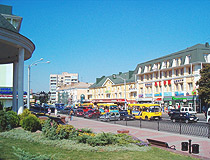
On a busy street in the center of Rivne
Author: Koshelyev
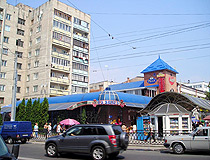
Small shops and an apartment building in Rivne
Author: Michal Palicuk
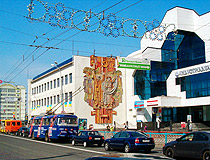
Soviet mosaic in Rivne
Author: Koshelyev
Rivne - Features
Rivne, located about 330 km west of Kyiv, is the third most populous city in western Ukraine after Lviv and Chernivtsi. The City Day of Rivne is celebrated on the last Sunday of August.
There are several versions of the origin of the city’s name (in Ukrainian - Rivne, in Russian - Rovno, in Polish - Rowne). According to one of them, the name comes from the location of the city on a flat (literally “rovnaya”) area. According to another version, it originates from the word “rov” (“moat”) because the first settlement was protected from the western direction by a river and from the east - by a moat.
The coat of arms of Rivne, approved in 1990, depicts three silver gates united by a defensive tower, which symbolizes the entrance to the city from three sides and repeats its historical coat of arms.
OJSC “Rivneazot”, located about 15 km from Rivne, is one of the largest plants in the chemical industry in Ukraine. It carries out about 50 types of activities, the main of which is the production, storage and sale of mineral fertilizers of the nitrogen and phosphorus groups to dozens of countries around the world.
Rivne repeatedly won prizes at all-Ukrainian competitions for the quality of urban improvement. Around the city there are forests with rich flora and fauna. The climate is temperate continental. The average temperature in January is minus 3.5 degrees Celsius, in July - plus 18.9 degrees Celsius.
It is located at the intersection of international highways and railways. Rivne connects the western part of Ukraine with the eastern one. For centuries, it was a county town of various European powers. This feature is reflected in its architectural appearance, making it attractive for those who want to get to know the historical past of Ukraine. There are a lot of romantic places, picturesque buildings, old churches, and interesting museums here.
Most of the unique buildings that made up the cultural heritage of Rivne were badly damaged or completely destroyed during the Second World War. Fortunately, some of the historical and architectural monuments have been preserved.
Rivne has absorbed the features of several western Ukrainian cities, which makes it attractive to many tourists. This city is also an important transit point when traveling through the west of Ukraine.
Main Attractions of Rivne
Rivne Zoo - one of the youngest zoos in Ukraine, founded in 1982. This is one of the main places of recreation for the locals and tourists. Today, the territory of 13.5 hectares is inhabited by about 150 species of animals (deer, Himalayan bears, monkeys, wild boars, foxes, wolves, different species of birds, etc.). 24 species of animals are listed in the international Red Book and the Red Book of Ukraine. The zoo has a cascade of artificial waterfalls and a picturesque orchard. Various holidays and festivals are also held here. Kyivs’ka Street, 110.
Taras Shevchenko Park of Culture and Rest - a monument of landscape art of national importance created at the end of the 18th century. It is the main park complex of Rivne with an area of 32 hectares and one of the best places for walking in the city. In total, over 160 species of shrubs and trees grow here including a lot of exotic ones from Japan and China, Central Asia and the Far East. Soborna Street, 3.
Park “Lebedynka” (Swan Lake Park). This is all that remains of the estate of the Polish princely family of Lubomirski, the former owners of Rivne. In the center of this park there is an artificial pond with swans, hence the name of the park. This is a great place for romantic walks. Drahomanova Street.
On Korolenka Street, which runs along the eastern border of the park, you can find the Alley of Forged Sculptures with a number of surrealistic pieces of art created by Rivne blacksmiths together with blacksmiths from other countries.
Rivne Regional Museum of Local Lore - the largest museum center in Rivne housed in the building of a former gymnasium built in the architectural style of classicism in 1839. In total, this museum has about 140 thousand historical, ethnographic and archaeological exhibits. You can also see a large numismatic collection and beautiful icons here. Drahomanova Street, 19.
Amber Museum - a unique museum for Ukraine opened in the building of the Rivne House of Scientists, a two-story mansion built in the Art Nouveau style in 1903. Among the exhibits of this small museum you can see pieces of amber up to 40 million years old found at different times in the territory of the Rivne region, as well as jewelry made from amber. The exhibits tell not only about the history of amber mining in the region, but also about the only enterprise in Ukraine that processes it. Symona Petlyury Street, 17.
Holy Assumption Church (1756) - the oldest building in Rivne preserved in its original form to this day, an architectural monument of national importance. The iconostasis of this church was created in 1784. A curious artifact can be found here - the “chain of moral foundations”, a small chain, to which wicked parishioners were chained for public atonement of sins before the community and as an edification to the rest. Shevchenka Street, 113.
Holy Resurrection Cathedral (1890-1895) - one of the most beautiful churches in Rivne, built with donations from Emperor Alexander III. Under Soviet rule, the museum of atheism was located here. In 1988, the cathedral was returned to the local Orthodox community. In architectural terms, it is a vivid example of the neo-Russian style, which was fashionable at the time of construction, interpreting the authentic traditions of old Russian architecture and folk art. Soborna Street, 39.
Holy Intercession Cathedral (1990-2001) - one of the tallest and most spacious churches in Ukraine, built with elements of the Ukrainian style. This snow-white cathedral, 55 meters high, has a large dome symbolizing Jesus Christ, 12 smaller ones symbolizing the apostles, as well as 8 small domes. Soborna Street, 6.
House of Chamber and Organ Music (1868-1900) - one of the most interesting buildings in Rivne, the former Catholic Church of St. Anthony, built in the neo-Gothic style. During the First World War, the church was partially destroyed, including the spires. On its facade you can see a wonderful clock. In 1987, thanks to its unique acoustics, the building was turned into a house of chamber and organ music of the Rivne Regional Philharmonic Society. Soborna Street, 137.
Tunnel of Love in Klevan - one of the most romantic places in Ukraine located about 20 km northwest of the center of Rivne. This monument of nature is a botanical phenomenon - intertwined bushes and trees created a dense arched tunnel. The tunnel runs a railway from the village of Klevan to the village of Orzhiv. There is a belief that if you make a wish here, it will surely come true. Couples in love come here to plant a flower in the tunnel and take unforgettable pictures.



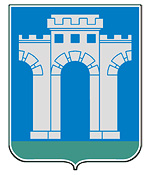



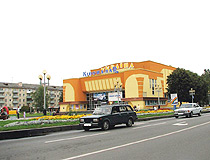
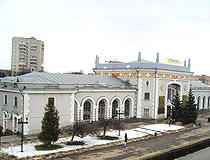
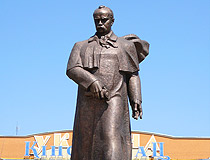
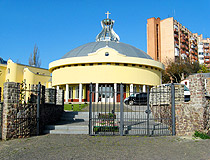
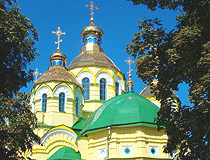
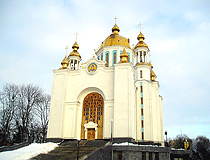
The comments of our visitors